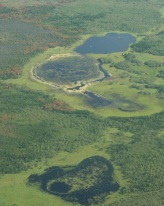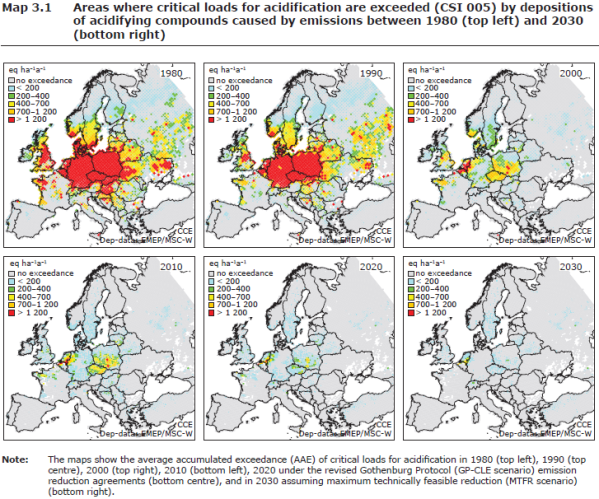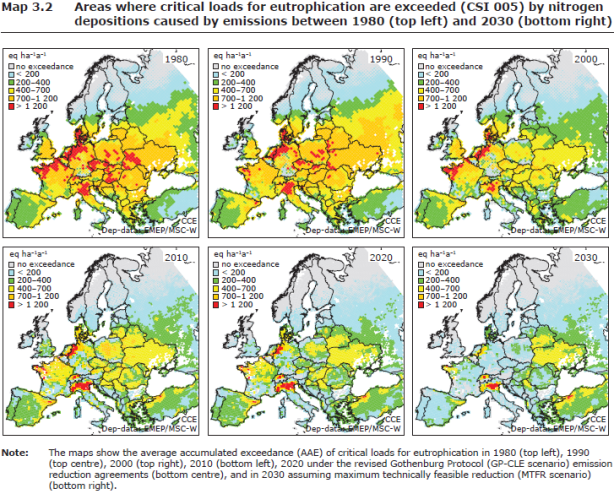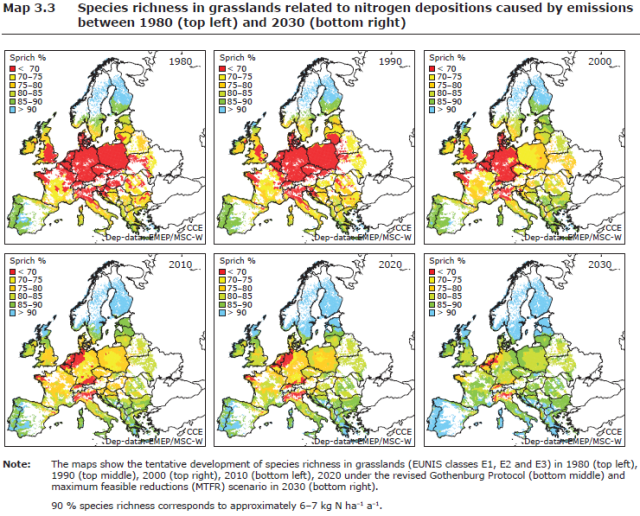“Effects of air pollution on European ecosystems” European Environment Agency technical report. Press release June 2014 (by Diego Fdez-Sevilla PhD)
 CV english and español. Resume. Interdisciplinary Skills applied in the line of research presented.- Index for all analyses published. – Shares and Feedback at LinkedIn. DOIs for those publications mentioned can be found at the Framework and Timeline Page.
CV english and español. Resume. Interdisciplinary Skills applied in the line of research presented.- Index for all analyses published. – Shares and Feedback at LinkedIn. DOIs for those publications mentioned can be found at the Framework and Timeline Page.
______________________________
The 30th June 2014 the European Environmental Agency has released a report about the ‘Effects of air pollution on European ecosystems‘. This report assesses the proportion of European ecosystems exposed to nitrogen and sulphur-containing pollutants above sustainable levels.
Poor air quality not only harms human health; it also impacts the structure and function of ecosystems, often far away from the emission sources. This report focuses on the deposition of airborne sulphur (S) and nitrogen (N) compounds and their negative effects on ecosystems. N- and S-containing air pollutants are released to the atmosphere by combustion processes such as the burning of coal or petrol, and by non-combustion processes such as agricultural fertiliser application (EEA, 2013a; EEA, 2014a).
Justification for indicator selection
Excess deposition of air pollutants can lead to disturbances in the function and structure of ecosystems. Deposition of sulphur and nitrogen compounds contributes to the acidification of soils and freshwaters. Negative effects are the leaching of plant nutrients from soils and damage to flora and fauna (changes in biodiversity). Deposition of nitrogen compounds can lead to an oversupply of nutrient nitrogen in terrestrial and water ecosystems, eutrophication . Effects can be changes in vegetation abundances or leaching of nitrate to groundwater.
The risk of damage of a sensitive ecosystem receptor at a certain location can be evaluated by comparing the estimated deposition of acidifying and eutrophying air pollutants to the critical load for that location. The critical load is the deposition below which adverse effects on specified sensitive elements of an ecosystem do not occur according to present knowledge. Critical loads for several (semi-)natural areas in Europe are computed under the Convention on Long-range Transboundary Air Pollution by the Coordination Centre for Effcets (CCE; see Hettelingh et al., 2008). Thus, an ecosystem is at risk of acidification or eutrophication when its critical load is exceeded by acidifying and eutrophying air pollutants, respectively. When critical loads are exceeded the actual damage to sensitive elements of an ecosystem may involve a time delay, dependent on soil, water and vegetation properties as well as combined effects due to for example climate change.
In the 1970s, many European governments became increasingly concerned about acid rain, which was damaging forests and killing fish such as the brown trout and Atlantic salmon.
Report’s outcome (extended below in the Executive summary)
The report shows that acidification has been greatly reduced since its peak in 1980 when almost half of the sensitive ecosystem area in the 28 EU Member States was affected. This has been reduced to around 5 % of ecosystems today, the report finds.
Eutrophication from air pollution peaked in 1990 with around 80 % of sensitive ecosystems in the EU exposed above safe levels. Despite some improvements almost 60 % of the ecosystems are still affected. While the situation is set to improve further, the report indicates that air pollution will cause significant eutrophication for some years to come.
Hans Bruyninckx, EEA Executive Director said: “Although air pollution does not cause as much harm as it once did, we are still struggling to protect sensitive ecosystems from harmful effects such as eutrophication. This changes habitats, endangering a wide range of species from fish to flowering plants. It is particularly striking that the problem appears to be just as bad in Europe’s protected natural areas.”
The report evaluates how European ecosystems were affected by acidifying and eutrophying air pollutants in the past decades, and also how they are predicted to be affected in the future if the 2012 amended Gothenburg Protocol under the Convention on Long-range Transboundary Air Pollution (LRTAP) will be fully implemented by 2020. The presented results will be used to inform forthcoming updates of the EEA Core Set Indicator ‘Exposure of ecosystems to acidification, eutrophication and ozone’ (CSI 005) (EEA, 2012a) and the biodiversity indicator ‘Critical load exceedance for nitrogen’ (Streamlining European Biodiversity Indicators; SEBI 009) (EEA, 2010a).
EEA report. Executive summary
Background
Over the last century, rising anthropogenic air pollutant emissions accompanied increasing industrialisation in Europe. Polluted air masses containing sulphur (S) and nitrogen (N) compounds can travel long distances over national borders and damage other countries’ resources: their freshwaters, forests, grasslands or cultural heritage (i.e. buildings, monuments, etc.).
Atmospheric deposition of such pollutants caused the past acidification of thousands of European lakes, rivers and streams. Fish species such as brown trout and Atlantic salmon, the latter a fish that spends most of its life in the sea before returning to fresh water to spawn, are particularly sensitive to acidification. ‘Acid rain’ led to the loss of fisheries in large regions of Sweden and Norway, with the issue being recognised as a major environmental problem by scientists and the public from the 1960s (e.g. Odén, 1968).
In the early 1970s symptoms of widespread forest decline appeared in central Europe, with the acidification of many forest soils first being regarded as a major cause in Germany (e.g. Ulrich et al., 1979). Scientific consensus subsequently emerged that acid deposition of S and N compounds was playing a significant role as predisposing or contributing factors leading to the observed impacts on trees.
To allow the quantification of environmental harm associated with air pollution, the so-called ‘critical loads’ concept was introduced as an effects-based tool for assessing the sensitivity of freshwater and terrestrial habitats to the harmful effects of S and N deposition (e.g. Nilsson and Grennfelt, 1988). A critical load is the upper limit of one or more pollutants, deposited to the Earth’s surface, that an ecosystem such as a lake or a forest can tolerate without being damaged in its function (as for example the nutrient nitrogen cycle) or its structure (as for example with respect to plant species richness). A positive difference between the deposition loads of acidifying and/or eutrophying airborne pollutants and the critical loads is termed an ‘exceedance’.
With respect to eutrophication, in different regions of Europe the atmospheric supply of nutrient N is in the range of around 2 to more than 40 kilograms per hectare per year (see Box 1.1 in Chapter 1). This has the potential to enrich the short- and long-term N content of soils, resulting in increased plant growth and hence species competition. The N supply via the air can therefore directly lead to eutrophication effects in terrestrial habitats, such as nutrient-poor grasslands. While excessive N stimulates the presence of nitrophilous (nitrogen loving) plant species, it reduces the occurrence of species adapted to low N availability. This in turn can lead to changes in species richness i.e. changes in biodiversity over time (e.g. Steven et al., 2004; Emmett et al., 2007).
Policy context
Air pollution
Internationally, a first step to address air pollution related impacts on health and the environment was the 1979 United Nations Economic Commission for Europe (UNECE) Geneva Convention on Long-range Transboundary Air Pollution (LRTAP Convention) (UNECE, 1979). A centrepiece of the convention is the Gothenburg Protocol to Abate Acidification, Eutrophication and Ground-level Ozone (UNECE, 1999), subsequently amended in 2012 (UNECE, 2012). The protocol sets national ceilings (limits) for the main air pollutants and established the critical loads concept as a tool able to inform political discussions concerning damage to sensitive ecosystems.
The Gothenburg Protocol was followed in 2001 by the European Union’s (EU’s) National Emission Ceilings (NEC) Directive which set specific environmental objectives addressing acidification and eutrophication impacts on ecosystems, to be met by 2010 (EC, 2001). The directive introduced legally binding national emission limits for four main air pollutants, including three important pollutants that contribute to acidification and eutrophication: sulphur dioxide (SO2), nitrogen oxides (NOX) and ammonia (NH3). The directive requires EU Member States to have met emission ceilings by 2010 and in years thereafter, although in actuality around half of all Member States missed at least one of their ceilings by 2010 (EEA, 2014a). The NEC Directive is currently under revision.
The long-term strategic objective and core of a new European Clean Air Package, proposed by the European Commission (EC) in December 2013, is to attain air quality levels that do not give rise to significant negative impacts on, or risks for, human health and the environment. Concerning ecosystem impacts the proposed text of the Strategy names as the long-term EU objective ‘no exceedance of the critical loads and levels which mark the limits of ecosystem tolerance’. More concrete the suggested goal is to achieve a situation where the EU ecosystem area exceeding critical loads for eutrophication is reduced to 35 % by 2030 (EC, 2013; Box ES.1).
Biodiversity
In April 2012, a new EU biodiversity strategy was adopted which is ‘aimed at reversing biodiversity loss and speeding up the EU’s transition towards a resource efficient and green economy’ by 2020 (EC, 2012). In the EU, the conservation status of habitat types of European interest in grassland ecosystems has been identified to be ‘unfavourable – bad’ for 54 % of the habitats. Agricultural intensification and land abandonment provide two of the main pressures on biodiversity linked to grassland ecosystems. Habitat fragmentation and conversion to biofuel or forest cultivation also represent growing threats (EEA, 2010b). Contributing to biodiversity harm, deposition of airborne nitrogen has also been identified as a threat because ‘such deposition encourages the growth of competitive plant species, favouring species-poor mesotrophic and eutrophic communities and reducing the structural density of grasslands’ (e.g. EC, 2008b; see also Box ES. 2).
Main findings
Applying latest scientific knowledge and a modelling approach consistent with the one used under the Gothenburg Protocol amendment and the NECD revision, this report has investigated the past and future (1880 to 2030) effects of the atmospheric deposition of S and N compounds on sensitive elements of the environment in Europe. Impacts on the following are discussed:
- ecosystem-types defined according to the European Nature Information System (EUNIS) Habitats classification (1);
- areas designated as Natura 2000 sites, a EU conservation network which aims at ensuring the long-term survival of Europe’s most valuable and threatened species and habitats, and
- species richness in selected grassland ecosystems, identified within the LRTAP Convention as a possible biodiversity indicator sensitive to the impacts of air pollution (see Box ES. 2).
A scenario is used that calculates probable conditions in past decades (a so-called hindcast scenario). It is based on emission trends since 1880 (Schöpp et al., 2003), with deposition patterns following different versions of the EMEP model (e.g. Hettelingh et al., 2013; Box 2.1). Further, two forecast scenarios are applied in this report (based on Amann et al., 2011):
- a (baseline) scenario assuming the implementation of current legislation (CLE) by 2020, as defined in the amended Gothenburg Protocol;
- a scenario assuming that between 2020 and 2030 maximum technically feasible reduction (MTFR) measures are implemented.
The report applies the concept of critical loads exceedances, using the most recent critical load database (Posch et al., 2012). Biodiversity-related results are based on a first application of a nitrogen dose–response relationship (Stevens et al., 2010a; Stevens et al., 2010b) for specific European grasslands defined according to EUNIS Habitats classification (EEA, 2014b).
The findings suggest that by 2020, the ecosystem area where critical loads are exceeded, as well as the absolute magnitude of exceedances, will be as low as they were in 1880, i.e. only 4 % of the EU-28 ecosystem area will still have exceedances of the acidification critical loads. The results do not change significantly if the focus is only on Natura 2000 areas, with approximately 2 % of these areas being projected to have exceedances of the acidification critical loads in 2020. It must be noted however that it may still take decades before ecosystems recover from acidification, even when they receive deposition not exceeding the critical loads (see e.g. ICP Waters, 2011).
Finally, the report presents the first assessment of possible impacts of nutrient nitrogen deposition on species richness in nutrient-poor grasslands. The use of species richness as a biodiversity indicator can be criticised because it may be influenced by, for example, invasive species. However, in this report the chosen indicator is used only in a relative sense, i.e. for comparing effects between scenarios or between countries.
Conclusions
As SO2 emissions have fallen, the relative contribution made by ammonia (NH3) emitted from agricultural activities and nitrogen oxides (NOX) emitted from combustion processes to surface water and soil acidification has increased or even become predominant in some regions in Europe. NH3 and NOX are also eutrophying air pollutants. The assessment findings shown in this report indicate that measures to abate SO2 and NOX emissions over the last decades have generally been successful in improving the situation related to acidification phenomena. In addition, structural changes in national economies, such as the decline in heavy industry and the closure of older inefficient power plants in certain countries, have also contributed to this development. Emissions of these two pollutants are projected to further decrease in future years but NH3 emissions will broadly stay constant to 2020, with agriculture as the main source.
When implementing current legislation, more than 50 % of the ecosystem areas classified according to the EUNIS habitats classification are expected to be still at risk of excessive nutrient N deposition in 2020. However, the magnitude of exceedances will decrease considerably. The relative (%) increase in grasslands’ species richness from 1990 to 2020 also indicates that emission reductions have a positive effect on biodiversity. This is similarly true for sensitive areas within the Natura 2000 network. Notwithstanding that the first approach presented in this report to address the effects of nutrient nitrogen deposition on species richness in grasslands has its limitations and uncertainties, the results suggest that further reductions in NOX and NH3 emissions will have positive effects on biodiversity in habitat types of European interest.
When assuming the implementation of maximum technically feasible reduction (MTFR) measures to reduce NH3 and NOX emissions between 2020 and 2030, decreases in critical load exceedances and increases in species richness in grasslands will be only slightly higher compared to the current legislation scenario. For example the increase in species richness is calculated to be 86 % in 2030, compared to 82 % when assuming the Gothenburg Protocol’s current legislation scenario.
Finally, the strategy proposed by the European Commission aims to achieve a situation in which the EU ecosystem area exceeding critical loads for eutrophication is reduced to 35 % by 2030 (EC, 2013; Box ES.1). According to the findings of this report, this goal cannot be achieved by 2030 even when implementing all technically feasible reduction measures (MFTR scenario) as the area at risk of eutrophication for the EU-28 is calculated to be 51 % in 2030.
Related info:
Related posts:
Effects of ecosystem’s degradation and the EEA report. (by Diego Fdez-Sevilla PhD)
Biological Productivity and its Influence on Cloud Formation. (by Diego Fdez-Sevilla PhD)







 Would you like for this line of research to keep going, please consider to nominate it for an award for funds at
BBVA Fundation. FRONTIERS OF KNOWLEDGE AWARDS
https://www.frontiersofknowledgeawards-fbbva.es/conditions/
Would you like for this line of research to keep going, please consider to nominate it for an award for funds at
BBVA Fundation. FRONTIERS OF KNOWLEDGE AWARDS
https://www.frontiersofknowledgeawards-fbbva.es/conditions/ orcid.org/0000-0001-8685-0206
orcid.org/0000-0001-8685-0206

Pingback: How Does Air Pollution Affect Natural Ecosystems? | Pollution Free Cities
(open debate with members from LinkedIn. Names are kept anonymously (unless specifically stated by author) for privacy reasons.)
———————
Research Engineer at FKE-TUWein
Anyone likely to mention chemtrailing?
Diego Fernández Sevilla, Ph.D.
Aerobiologist and Environmental Research Analyst (in job search mode worldwide. diegofdezsevilla.wordpress.com)
I am a messenger here and I just wanted to bring awareness about this report as it is, without any interference and just transmitting what they have done as you can see if you look at the whole report in the link to the EEA web site. Before entering to discuss its value I just wanted to make a common ground.
Once I have said that, I was surprised by the big umbrella that the title covers and the lack of interactions and mechanisms considered in the report.
What about alterations over; the plants metabolism (photosynthesis, degradation of defence systems, alteration of protein synthesis, to begin with), soil degradation, synergistic effects soil-flora-fauna, groundwater and the very important issue of how ecosystem degradation has an impact on human health.
Visiting profesor, at Forest Science Faculty, UANL
This excellent and highly educative.
Professor at Ambo University
Thanks Diego…..yes this is a broad title…and not covering many related issues as you mentioned….but with limited scope..the Report within 38 Pages…can not cover all. It is a good source for beginning.
Cropping Systems Agronomy at IRRI
Thanks for writing a good report.
LikeLike
Pingback: 2014 in review. One year trying to “Fill in” or “Find out” gaps of knowledge. (by Diego Fdez-Sevilla) | diego fdez-sevilla
Pingback: SOILS. The Skeleton Holding The Meat Of Our Ecosystems (by Diego Fdez-Sevilla) | diego fdez-sevilla
Pingback: Climbing The Hill Of Development (by Diego Fdez-Sevilla, PhD.) | diego fdez-sevilla, PhD.